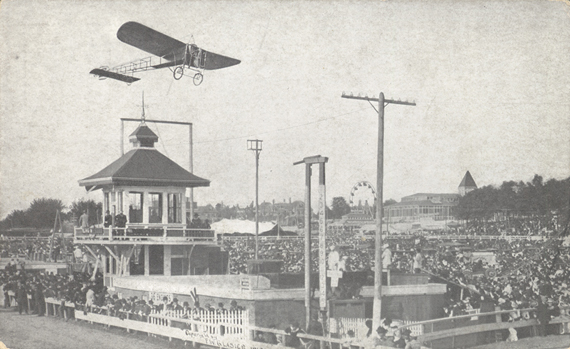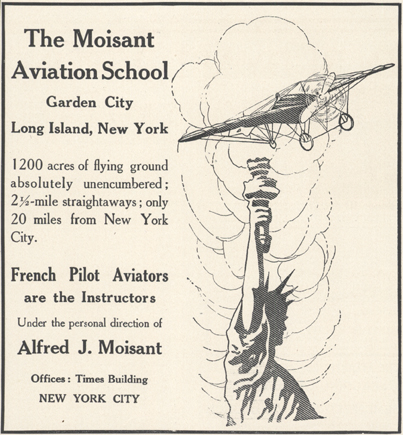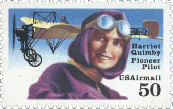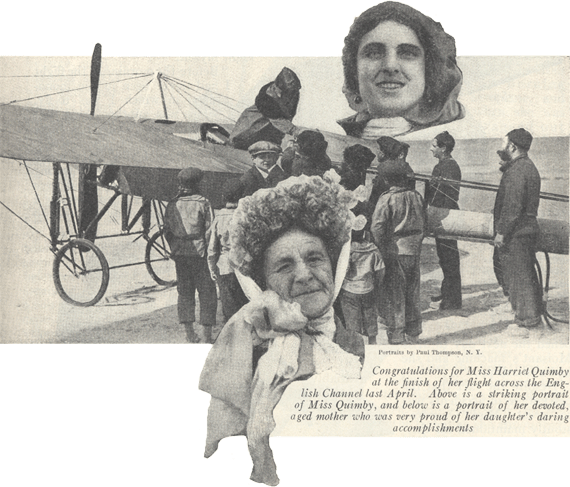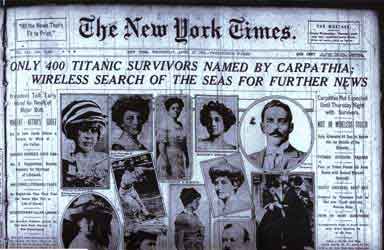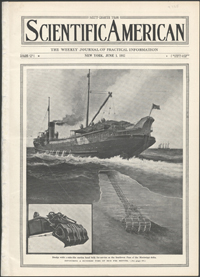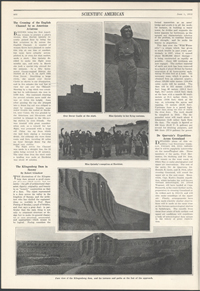Harriet Quimby's Flight Across the English Channel
Next | Previous | Return to Start
|
While covering the 1910 Belmont Park Aviation Meet for Leslie's Illustrated Weekly, Harriet's interest in aviation soared. She convinced her paper to pay the $750 for flight school, and began taking lessons in secret on May 1, 1911 at the Moisant Flight School at Hempstead Plains, Long Island under chief flight instructor Andre Haupert. The secret did not last long, and she began writing articles about her experiences. On August 1, 1911, she finished the last of three tests required by the International Aeronautical Federation and confirmed by Aero Club of America, and she received her pilot's license, the first woman in the US and second in the world to do so. She joined the ranks of early pilots less than eight years after the Wright brothers' first flight.
Perhaps her most significant achievement occurred on the morning of April 16, 1912, when Harriet Quimby became the first woman to fly across the English Channel. |
|
The Flight In Her Words
"It was a cold five-thirty a.m. when my machine got off the ground. The preliminaries were brief. Hearty handshakes were quickly given, the motor began to make its twelve hundred revolutions a minute, and I put up my hand to give the signal of release. Then I was off. The noise of the motor drowned the shouts and cheers of friends below. In a moment I was in the air, climbing steadily in a long circle. I was up fifteen hundred feet within thirty seconds. From this high point of vantage, my eyes lit on Dover Castle. It was half hidden in a fog bank. I felt that trouble was coming, but I made directly for the flagstaff of the castle, as I had promised the waiting MIRROR photographers and the moving-picture men I should do. "In an instant I was beyond the cliffs and over the channel. Far beneath me I saw the MIRROR's tug, with its steam of black smoke. It was trying to keep ahead of me, but I passed it in a jiffy. Then the thickened fog obscured my view. Calais was out of sight. I could not see ahead of me nor could I see the water below. There was only one thing for me to do and that was to keep my eyes fixed on the compass. "My hands were covered with long Scotch woolen gloves, which gave me good protection from the cold and fog; but the machine was wet and my face was so covered with dampness that I had to push my goggles up on my forehead. I could not see through them. I was traveling at over a mile a minute. The distance straight across from Dover to Calais is only about twenty-two miles, and I knew that land must be in sight if I could only get below the fog and see it. So I dropped from an altitude of about two thousand feet until I was half that height. The sunlight struck upon my face and my eyes lit upon the white and sandy shores of France. I felt happy, but I could not find Calais. Being unfamiliar with the coast line, I could not locate myself. I determined to reconnoiter and come down to a height of about five hundred feet and traverse the shore. "Meanwhile, the wind had risen and the currents were coming in billowy gusts. I flew a short distance inland to locate myself or find a good place to alight. It was all tilled land below me, and rather than tear up the farmers' fields I decided to drop down on the hard and sandy beach. I did so at once, making an easy landing. Then I jumped from my machine, and I was alone upon the shore. But it was only a few moments. A crowd of fishermen--men, women, and children each carrying a pail of sand worms--came rushing from all directions toward me. They were chattering in French, of which I comprehended sufficient to discover that they knew I had crossed the channel. These humble fisherfolk knew what had happened. They were congratulating themselves that the first woman to cross in an aeroplane had landed on their fishing beach." |
|
|
The New York Times Story about the Flight |
|
|
On April 17, 1912, the news in the New York Times and other papers focused on the Titanic, which hit an iceberg shortly before midnight April 14 and sank early in the morning on the 15th. The following article appeared on page 15. MISS QUIMBY FLIES --------------- By Marconi Transatlantic Wireless Telegraph LONDON, April 16.---Miss Harriet Quimby, the American airwoman, flying under the name of "Miss Craig," flew across the English Channel today, being the first woman pilot to accomplish this feat. --------------- Miss Quimby's feat is not the first in which this particularly daring young woman has led the way for her sex. She won the first air diploma for a woman in America, made the first flight by a woman in this country, and for a period held the American endurance record. The Scientific American Story about the Flight |
The Article on Page 15: |
|
On June 1, 1912, the following article appeared in Scientific American with photos of her plane high above the castle at Dover, Harriet standing in her famous flying costume front of her plane, and Harriet being carried in celebration on the beach at Hardelot. The Crossing of the English Channel by an American Aviatress BESIDES being the first American woman to procure a pilot's license, Miss Harriet Quimby recently gained fame by being the first aviatress to fly across the English Channel. A number of women flyers have planned to make this trip at one time or another, but none have actually accomplished it, or even, for that matter, made a start. Miss Quimby decided to make this flight some months ago, and early in March she took a special trip abroad for the purpose. In a fifty horsepower Gnome-engined Bleriot she started at 4 A. M. on April 16 from Dover. Describing a large circle, she passed over Dover Castle as shown in our illustration, and in five minutes she was lost to view far out over the Channel. Steering by a tug which was awaiting her in mid-channel, she rose to 3,000 feet. She continued climbing for several minutes more until she was at twice the height. Soon after passing the tug she plunged into a dense fog and was obliged to steer by compass. Despite some motor trouble she landed at Hardelot, near Calais. She was greeted by the fishermen and life-savers and carried in triumph to the life-saving station by some friends. She was treated with great consideration and, as a reward for her flight, was presented with a large old China tea cup from which she had been sipping a warming drink; for although she wore three coats and furs, traveling 60 miles an hour through dense fog she found very chilling. The flight across the Channel was made in a straight line, the 22 miles being covered in 20 minutes. The total time from start until a landing was made at Hardelot was about 40 minutes. |
|
